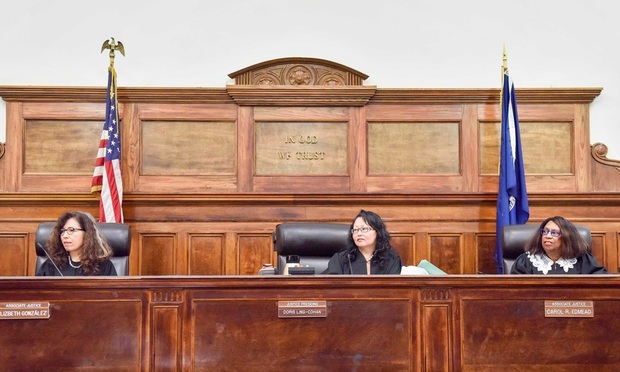Visibility Matters: Diversity Needed on Both Sides of the Bench
The attorneys appearing in our courts should similarly reflect the varied population they represent, and the judiciary must actively encourage this important goal.
March 14, 2018 at 10:12 AM
6 minute read

On March 5, as reported by the New York Law Journal,[1] for the first time in New York State history, an all-women panel of justices convened over appellate arguments in the Appellate Term, First Department.[2] Further, all three justices are women of color, marking the first time an Asian Pacific American, Latina and African-American justice comprised a panel. I proudly sat as presiding justice alongside my colleagues Justice Lizbeth González and Justice Carol Edmead on that momentous day, coincidentally assembled during this Women's History Month.
To be sure, the occasion signified an important day in our state's history, and we owe much to our female predecessors in the Appellate Term, and in all courts, upon whose shoulders we now stand. Regrettably, my view from the bench into the audience of attorneys on that historic morning failed to display the same picture of intersectional diversity. When the calendar call began, I noticed something remarkable: All but one of the attorneys who argued on that day were men, and all were white.
The composition of attorneys at our March 5 arguments was clearly inconsistent with the day's message of inclusion. Indeed, one might think Justice Joseph Bradley had written just yesterday that, “[t]he natural and proper timidity and delicacy which belongs to the female sex evidently unfits it for [the practice of law].”[3] Of course, one glance at the members of the bench on such a notable day would undermine his characterization.
Unlike the judiciary of our state (the Court of Appeals had a majority of women for over 10 years, including two female chief judges), it appears that the attorneys who argue before our courts are not equally as diverse. Women attorneys only account for approximately 25 percent or less of speaking roles “in every level and every type of court: upstate and downstate, federal and state, trial and appellate, criminal and civil, ex parte applications and multi-party matters.”[4] The issues leading to the dearth of women trial lawyers “apply with even greater force to women trial attorneys of color, who face the double bind of gender and race.”[5]
We, as judges and members of the bar, must continue to promote greater inclusion throughout the legal profession. In the courtroom, judges have an unparalleled opportunity to affect change. Notably, my federal colleagues have begun taking proactive steps to ensure needed diversity among the attorneys who appear, and speak, before them. Judge Jack Weinstein (ED NY),[6] Judge Ann Donnelly (ED NY)[7] and Chief District Judge Barbara M.G. Lynn (ND TX),[8] among others, have amended their rules to allow junior attorneys, many of whom are women and from diverse communities, to speak in their courtrooms. These innovators recognize that simply including diversity in the legal profession, but relegating them to nonspeaking roles, cannot stand.
Why does increasing in-court participation of diverse attorneys matter? Increasing visibility of women and diverse attorneys adds to their legitimacy as advocates. Speaking in court allows new attorneys to develop crucial skills, which ultimately provides them more professional opportunities. Those attorneys who appear and speak in open court convey subtle messages to the public about who practices law. Moreover, equal representation in the profession at all levels promotes confidence and trust in our system of law.
I celebrate that New York State has made great strides in the diversity of the judiciary, and I am honored to be a part of that legacy. Our courts sit at the forefront of the pursuit of justice and equality; aptly, the composition our judiciary has slowly begun to mirror that of its diverse constituents. The attorneys appearing in our courts should similarly reflect the varied population that they represent, and the judiciary must actively encourage this important goal.
Of the 13 cases on for argument that historic Monday, it seems implausible that only one woman and no attorneys of color contributed to the preparation of the written submissions. However, only one diverse attorney was given a speaking role. Visibility does matter. We must encourage the invisible and unseen attorneys to speak before us and bring them into the consciousness of the legal community. As state court judges, we should similarly innovate, as our federal counterparts have done. Amending our rules to encourage junior attorneys to argue even part of an appellate argument or motion would be a big step towards visibility and equality in our profession.
Justice Doris Ling-Cohan is an associate justice of the Appellate Term, First Department and handles a Commercial Contracts Part in Supreme Court. She is a member of the Franklin H. Williams Judicial Commission. Article prepared with assistance by Rebecca I. Wohl, Esq., member, Women in the Legal Profession Committee, New York City Bar Association.
[1] ”Appellate Panel Makes History,” NYLJ, Mar. 6, 2018 at 2.
[2] This may have been the first time an all-female appellate panel has been convened in New York State, as our limited research did not disclose any previous instance.
[3] Bradwell v. People of State of Illinois, 83 US 130, 141 (1872, Bradley, J., concurring). Bradley penned his concurrence 145 years ago.
[4] New York State Bar Association, “If Not Now, When?: Achieving Inequality for Women Attorneys in the Courtroom and in ADR at 15″ (Nov 2017), available at http://www.nysba.org/WomensTaskForceReport/ (accessed Mar. 12, 2018).
[5] Stephanie A. Scharf and Roberta D. Liebenberg, “First Chairs at Trial: More Women Need Seats at the Table,” American Bar Foundation and Committee on Women in the Profession, American Bar Association at 15 (2015), available at https://www.americanbar.org/content/dam/aba/marketing/women/first_chairs2015.authcheckdam.pdf (accessed Mar. 12, 2018).
[6] See Individual Motion Practice of Judge Jack B. Weinstein, U.S. District Court, available at https://img.nyed.uscourts.gov/rules/JBW-MLR.pdf (accessed Mar. 12, 2018).
[7] See Judge Ann Donnelly “Individual Practice and Rules § 3 Courtroom Opportunities for Relatively Inexperienced Attorneys,” available at https://img.nyed.uscourts.gov/rules/AMD-MLR.pdf (last updated Sept. 27, 2017).
[8] See Chief District Judge Barbara M.G. Lynn, “Judge Specific Requirements §§ (II) (C) Opportunities for Young Lawyers,” available at http://www.txnd.uscourts.gov/judge/chief-district-judge-barbara-mg-lynn (accessed Mar. 12, 2018).
This content has been archived. It is available through our partners, LexisNexis® and Bloomberg Law.
To view this content, please continue to their sites.
Not a Lexis Subscriber?
Subscribe Now
Not a Bloomberg Law Subscriber?
Subscribe Now
NOT FOR REPRINT
© 2025 ALM Global, LLC, All Rights Reserved. Request academic re-use from www.copyright.com. All other uses, submit a request to [email protected]. For more information visit Asset & Logo Licensing.
You Might Like
View All
A Biblical Reconciliation Between Judaism and Islam: A Lesson for Everyone, Everywhere
6 minute readTrending Stories
- 1Uber Files RICO Suit Against Plaintiff-Side Firms Alleging Fraudulent Injury Claims
- 2The Law Firm Disrupted: Scrutinizing the Elephant More Than the Mouse
- 3Inherent Diminished Value Damages Unavailable to 3rd-Party Claimants, Court Says
- 4Pa. Defense Firm Sued by Client Over Ex-Eagles Player's $43.5M Med Mal Win
- 5Losses Mount at Morris Manning, but Departing Ex-Chair Stays Bullish About His Old Firm's Future
Who Got The Work
J. Brugh Lower of Gibbons has entered an appearance for industrial equipment supplier Devco Corporation in a pending trademark infringement lawsuit. The suit, accusing the defendant of selling knock-off Graco products, was filed Dec. 18 in New Jersey District Court by Rivkin Radler on behalf of Graco Inc. and Graco Minnesota. The case, assigned to U.S. District Judge Zahid N. Quraishi, is 3:24-cv-11294, Graco Inc. et al v. Devco Corporation.
Who Got The Work
Rebecca Maller-Stein and Kent A. Yalowitz of Arnold & Porter Kaye Scholer have entered their appearances for Hanaco Venture Capital and its executives, Lior Prosor and David Frankel, in a pending securities lawsuit. The action, filed on Dec. 24 in New York Southern District Court by Zell, Aron & Co. on behalf of Goldeneye Advisors, accuses the defendants of negligently and fraudulently managing the plaintiff's $1 million investment. The case, assigned to U.S. District Judge Vernon S. Broderick, is 1:24-cv-09918, Goldeneye Advisors, LLC v. Hanaco Venture Capital, Ltd. et al.
Who Got The Work
Attorneys from A&O Shearman has stepped in as defense counsel for Toronto-Dominion Bank and other defendants in a pending securities class action. The suit, filed Dec. 11 in New York Southern District Court by Bleichmar Fonti & Auld, accuses the defendants of concealing the bank's 'pervasive' deficiencies in regards to its compliance with the Bank Secrecy Act and the quality of its anti-money laundering controls. The case, assigned to U.S. District Judge Arun Subramanian, is 1:24-cv-09445, Gonzalez v. The Toronto-Dominion Bank et al.
Who Got The Work
Crown Castle International, a Pennsylvania company providing shared communications infrastructure, has turned to Luke D. Wolf of Gordon Rees Scully Mansukhani to fend off a pending breach-of-contract lawsuit. The court action, filed Nov. 25 in Michigan Eastern District Court by Hooper Hathaway PC on behalf of The Town Residences LLC, accuses Crown Castle of failing to transfer approximately $30,000 in utility payments from T-Mobile in breach of a roof-top lease and assignment agreement. The case, assigned to U.S. District Judge Susan K. Declercq, is 2:24-cv-13131, The Town Residences LLC v. T-Mobile US, Inc. et al.
Who Got The Work
Wilfred P. Coronato and Daniel M. Schwartz of McCarter & English have stepped in as defense counsel to Electrolux Home Products Inc. in a pending product liability lawsuit. The court action, filed Nov. 26 in New York Eastern District Court by Poulos Lopiccolo PC and Nagel Rice LLP on behalf of David Stern, alleges that the defendant's refrigerators’ drawers and shelving repeatedly break and fall apart within months after purchase. The case, assigned to U.S. District Judge Joan M. Azrack, is 2:24-cv-08204, Stern v. Electrolux Home Products, Inc.
Featured Firms
Law Offices of Gary Martin Hays & Associates, P.C.
(470) 294-1674
Law Offices of Mark E. Salomone
(857) 444-6468
Smith & Hassler
(713) 739-1250









